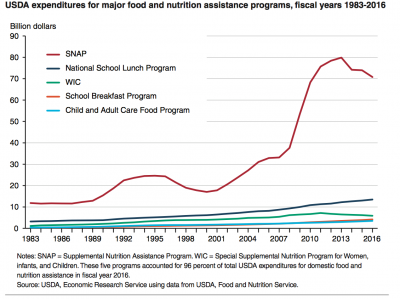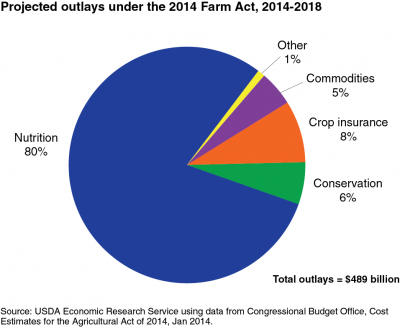Farm Progress' Joshua Baethge reported at the end of last week that "it’s hard to find anyone optimistic about passing a new farm bill this year. While the two political…
Farm Bill: Chairman Conaway Continues to Highlight SNAP Concepts
On Wednesday, House Agriculture Committee Chairman Mike Conaway (R., Tex.) was a guest on the Adams on Agriculture radio program where he discussed the Farm Bill and SNAP issues with host Mike Adams. An audio replay of their discussion can be heard here (MP3- 8:00 minutes), and a transcript of the program is available here.
At the outset, Mr. Adams indicated that, “House Ag Democrats say a Republican farm bill would cut an estimated one million people from food stamps and could slash spending on food stamp benefits by more than $20 billion over a decade.”
Chairman Conaway explained,
[T]he million people that you talk about come off the program either of two ways. Either they’ve gotten a job that is paying them more money than the 130% of poverty, where they’re making their own money, taking care of their own families, or they decide for themselves that meeting these requirements to get the training or get a job is not worth working 20 hours a week on and they self-select and get off.
“So those are the only two ways that people get off the program, is either decide for themselves they don’t want to be on it—and this is America, you get to make that call—or, if you want to better yourself, you want to get off these programs, or you’re working the 20 hours or more a week, then you stay on the program.
“So I’m not sure what the 20 billion is. That’s a number that’s unfamiliar to me. You’ll need to talk to the folks who made that up to find that. But we keep all of the money under the current baseline in the program. We didn’t have to come up with any spending reductions. So whatever that ten year baseline is for the existing farm bill, that’s what we live under. I keep all of the money in SNAP in SNAP, keep all the money that’s in the other programs in those other programs. So I’m not sure where they’re coming up with the 20 billion.”

Chairman Conaway noted that, “But this is an opportunity to reinvest monies back into job training, guaranteed slots, that if you’re 18 to retirement age, that each state will have to provide you a training slot that would involve apprenticeships, training, [WIOA], subsidized employment, or you’re working 20 hours a week then you’re still going to be on these programs.”
“The other thing we’ve done is that we’ve modernized the standards by which we measure. The asset test that has been in place since the early ‘70s—the last time that number was changed was 1977—we modernize that number by inflating it to current date…we also allow for a savings account that doesn’t count against the asset test…[and]…we also modernize the vehicle value that does not count against you under the asset test to make sure that you’ve got that car that’s reliable enough to get you to and from work.”
Federal food expenditures for @USDA’s domestic food and nutrition assistance programs totaled $98.6 billion in fiscal year (FY) 2017, or almost 4% less than in the previous fiscal year https://t.co/RFIfh3ycu0 @USDA_ERS pic.twitter.com/uhznJOMAuT
— Farm Policy (@FarmPolicy) March 27, 2018
With respect to prospects on passing the Farm Bill, Chairman Conaway stated that, “Well, we’ll see where the opposition comes from. We’ve had good conversations with the folks who are the most protective of SNAP programs, the NGOs and others out there, Catholic services and others that have had direct, keen interest in not cutting food stamps. The conversation we’ve had with them has been very positive. They’re anxious to see the language, of course.
But I think once the American people see this, and once my Democrat colleagues see exactly what we’re actually doing as opposed to what they’ve been told it’s doing, which is, from what I can tell, is not exactly accurate, then I think they’ll see the value of it and join us.
“Folks who want to vote against it, vote against it, and they then get to look their constituents in the eye and tell them why the safety net is not important for production agriculture, why these improvements to SNAP are not important to the SNAP beneficiaries and to the taxpayers of the country.”
PFMA and its members participated in a roundtable discussion with @CongressmanGT at the @centralpafb yesterday. The Congressman said that there are no planned cuts to SNAP, but the system will be modernized to help recipients overcome the poverty cliff. pic.twitter.com/qgjewluuTo
— PFMA (@PAFoodMerchants) March 28, 2018
Chairman Conaway also stated, “We’ll get the language out as soon as we get the April 9th baseline official from CBO. We think we’re good to go on that number, but we want to make sure that what we’re doing fits in the parameters I’ve already discussed about no reductions to our spending. And if it does, then we’ll get the language out and go to committee pretty quickly, and we’ll see where everybody is.”
THREAD: 1/ Yesterday morning, I joined with farmers, small business owners, seniors, food policy advocates, & SNAP recipients at @RdgTerminalMkt to highlight the critical role SNAP plays in our city and region, and to oppose any cuts to this vital program.
— Dwight Evans (@RepDwightEvans) March 28, 2018
Meanwhile, Sam Brodey reported on Tuesday at the MinnPost (Minneapolis, Minn.) Online that, “The Farm Bill, though it’s among the most significant projects Congress takes up, has historically been more defined by regional fault lines than by partisan ones, with lawmakers angling for provisions favorable to the interests they represent, whether it be Arkansas rice growers, Minnesota soybean growers, or California dairy farmers.
Kevin Paap, president of the Minnesota Farm Bureau, told MinnPost that ‘the Farm Bill, and the Agriculture Committee in general, has always been that shining example of how Congress is supposed to work.’
“Combining funding for agriculture and nutrition programs, as the Farm Bill does, was intended to bolster popular support for the legislation and help it move beyond partisan battle lines.”
Mr. Brodey noted, “What’s called the Farm Bill is mainly a nutrition bill, says Marin Bozic, an assistant professor at the University of Minnesota who specializes in agricultural economics. In the last Farm Bill, 80 percent of the $956 billion laid out went to nutrition programs, with the lion’s share of that total going to SNAP.
“The ‘farm’ part of the Farm Bill accounted for over $130 billion of the 2014 legislation, much of that to fund the safety net programs that help insulate U.S. agriculture producers from fluctuations in the global market, bad growing seasons, and other outside factors.

“‘Whenever you have a Farm Bill, you need to build a coalition of congressmen and senators who are supportive of nutrition programs, and those who are supportive of the farm programs,’ Bozic explains. ‘Separately, neither interest group has the necessary majority to do this on their own.’ Paap explains the political calculus another way: ‘You may not know a farmer, but everyone eats.'”





